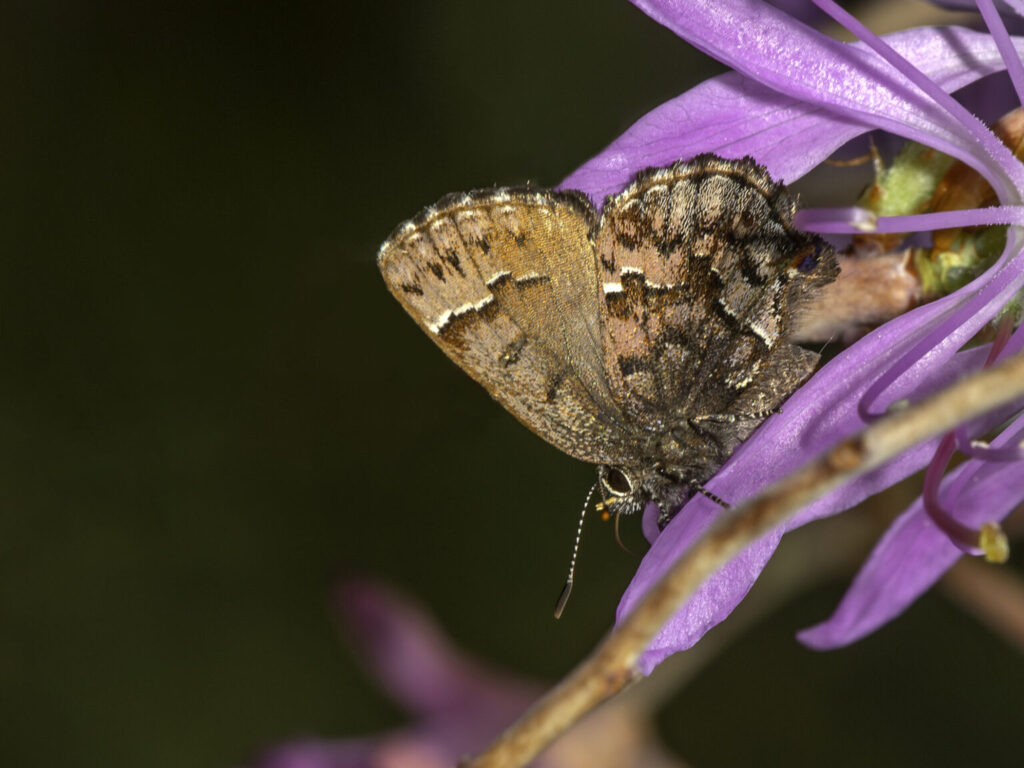After Two Decades of Searching a Rare Butterfly is Discovered during the Vermont Butterfly Atlas

About the size of a penny, a Bog Elfin, its wings folded up over its body, sips nectar among the petals of a rhodora flower. © Bryan Pfeiffer | Redistribution or any other use of this image is prohibited without express written permission of the Vermont Center for Ecostudies or the copyright owner.
Nearly every spring for the past 21 years, Bryan Pfeiffer has trekked into some of the most remote bogs across Vermont. Along the way, he donated blood to black flies, sunk into muck, and on occasion wondered whether he’d get out of certain bogs alive.
Year after year, Pfeiffer never found what he was searching for: Bog Elfin, one of the smallest and most elusive butterflies on the continent, and a rarity nobody had ever seen in Vermont.
But persistence and experience finally paid off in mid-May when Pfeiffer, alone in northern Vermont, finally caught up with the tiny butterfly — and lived to tell about it.
“I half figured that I would either find this butterfly or die trying,” said Bryan Pfeiffer, 65, a writer and entomologist who finally located the elfin at a bog in northern Vermont on May 19.
One of the smallest butterflies on the continent, Bog Elfin is notoriously hard to locate. Not only does it spend most of its life high in black spruce trees, it is on the wing and detectable for only a few weeks from mid-May to early June. Complicating the search are hoards of biting black flies.
Pfeiffer’s fateful discovery coincides with the launch this spring of the second Vermont Butterfly Atlas, which enlists experts and novices alike to search the state for butterflies and report what they find. Kent McFarland, who directs the butterfly atlas for the Vermont Center for Ecostudies (VCE), said the elfin’s discovery illustrates how much remains to be known about the state’s biological diversity, particularly its insect life.
“When it comes to discovering biodiversity, many of us think of far-off exotic places,” said McFarland. “But there’s plenty to find here in our own backyards.”
Repeated every 20 years, the five-year butterfly atlas (2023-2027) is but one project of VCE’s ambitious Vermont Atlas of Life, an online catalog of the state’s biodiversity. “We’re still seeking volunteers for the atlas,” McFarland said, “and you don’t need to know much about butterflies to contribute.”
Pfeiffer’s search for the Bog Elfin began during the previous butterfly atlas in 2002. Imperiled or vulnerable across much of its range, the elfin had been known only from limited parts of the northeastern US and eastern Canada, but not Vermont. Threats include global warming, pesticides and draining or flooding of spruce bogs.
“Discovering the Bog Elfin in Vermont is a testament to our ongoing commitment to land conservation and biodiversity,” said Natural Resources Secretary Julie Moore. “When we protect and restore a diversity of habitats, we ensure a thriving future for Vermont wildlife — both familiar and elusive.”
Moore added that the past year has seen multiple species of conservation interest discovered or rediscovered on land conserved and managed by the Agency of Natural Resources, including lands prioritized by the agency’s planning tool Vermont Conservation Design.
“When we protect the most important natural features across our landscape, we’re protecting all the pieces that make an ecosystem whole,” Moore said, “from the smallest butterfly to the largest ranging mammals, from common trees to rare plants and everything in between.”
Although he has pursued and studied wildlife from the tropics to above the Arctic Circle, Pfeiffer has a particular fondness for bogs and their suite of birds, insects and plants, including orchids. And while he recognizes that few people will ever see a bog elfin in the wild, and might even dismiss it as little more than an obscure brown insect, Pfeiffer sees grandeur in the tiny butterfly.
“Most of us will never see a Polar Bear, but we know that the Arctic is a better place for having them,” he said. “Vermont is a better place for having Bog Elfins up there in the spruce where they belong, overseeing orchids and songbirds and blackflies — or even besotted and aging biologists like me.”






